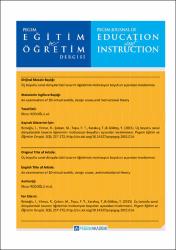| dc.contributor.author | Reisoğlu, İlknur | |
| dc.contributor.author | Yılmaz, Rabia Meryem | |
| dc.contributor.author | Çoban, Murat | |
| dc.contributor.author | Topu, Fatma Burcu | |
| dc.contributor.author | Topu, Fatma Burcu | |
| dc.contributor.author | Karakuş, Türkan | |
| dc.contributor.author | Göktaş, Yüksel | |
| dc.date.accessioned | 2020-12-19T19:56:46Z | |
| dc.date.available | 2020-12-19T19:56:46Z | |
| dc.date.issued | 2015 | |
| dc.identifier.citation | Reisoğlu, I., Yılmaz, R., Çoban, M., Topu, F. B., Karakuş, T., & Göktaş, Y. (2015). An examination of 3D virtual worlds, design issues, and motivational theory. Pegem Journal of Education and Instruction, 5(3), 257–272. https://doi.org/10.14527/pegegog.2015.014 | en_US |
| dc.identifier.issn | 2148-239X | |
| dc.identifier.uri | https://doi.org/10.14527/pegegog.2015.014 | |
| dc.identifier.uri | https://hdl.handle.net/11436/2777 | |
| dc.description | Karakus Yilmaz, Turkan/0000-0002-5809-3962; | en_US |
| dc.description | WOS: 000420771300003 | en_US |
| dc.description.abstract | The purpose of this study is to assess the motivational qualities of specific design elements in a three-dimensional (3D) virtual winter sports learning environment comprised of an Information House, Practice Area, and Exercise Area by considering two motivational models. the study employed causal comparative research methods. Participants included 150 fifth, sixth, and seventh grade middle school students. A motivation survey developed by the researchers served as the data collection tool; data were analyzed with descriptive and predictive methods. Data analysis revealed that the animations in the Practice Area of the 3D virtual environment drew the most attention when compared to the other design elements. Elements in the Exercise Area encouraged students to conduct more research, and elements in the Information House were efficient at increasing students' satisfaction. in addition, design elements such as animations, images, display boards, and videos helped students to learn individually and provided opportunities to practice within a 3D virtual environment. | en_US |
| dc.language.iso | tur | en_US |
| dc.publisher | Pegem Akad Yayincilik Egitim Danismanlik Hizmetleri Tic Ltd Sti | en_US |
| dc.rights | info:eu-repo/semantics/openAccess | en_US |
| dc.subject | 3D virtual worlds | en_US |
| dc.subject | Second Life | en_US |
| dc.subject | Motivation | en_US |
| dc.subject | Design components | en_US |
| dc.title | An examination of 3D virtual worlds, design issues, and motivational theory | en_US |
| dc.type | article | en_US |
| dc.contributor.department | RTEÜ, Eğitim Fakültesi, Bilgisayar ve Öğretim Teknolojileri Eğitimi Bölümü | en_US |
| dc.contributor.institutionauthor | Reisoğlu, İlknur | |
| dc.identifier.doi | 10.14527/pegegog.2015.014 | |
| dc.identifier.volume | 5 | en_US |
| dc.identifier.issue | 3 | en_US |
| dc.identifier.startpage | 257 | en_US |
| dc.identifier.endpage | 272 | en_US |
| dc.ri.edit | oa | en_US |
| dc.relation.journal | Pegem Egitim ve Ogretim Dergisi | en_US |
| dc.relation.publicationcategory | Makale - Uluslararası Hakemli Dergi - Kurum Öğretim Elemanı | en_US |


















